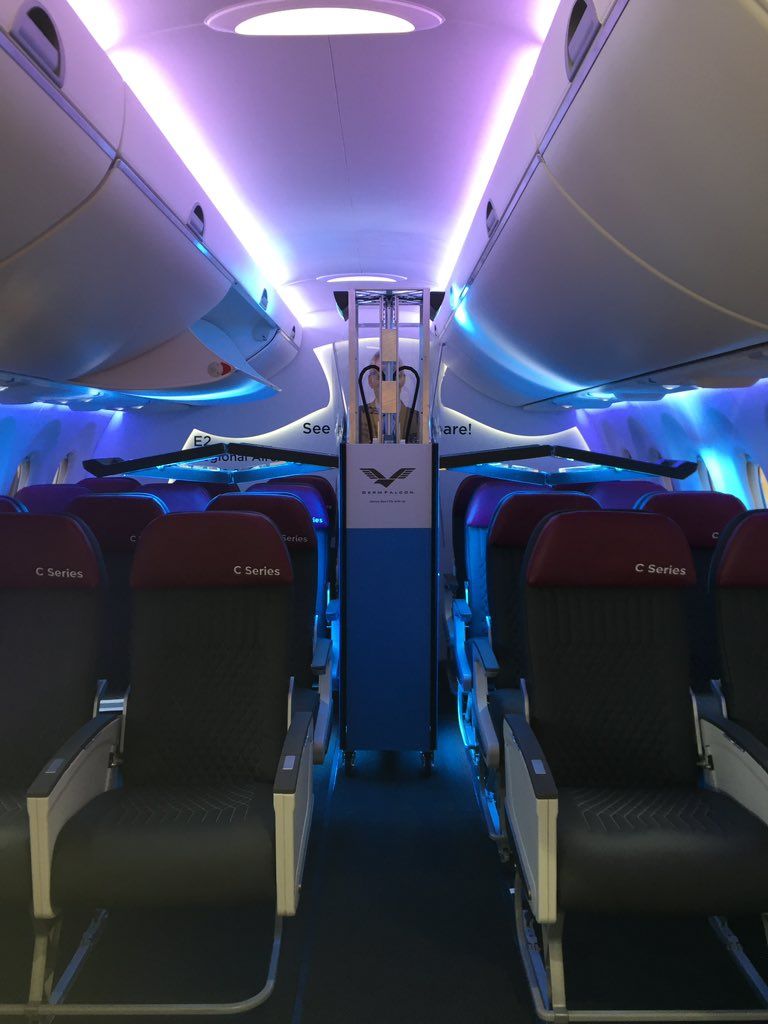Flight of the GermFalcon: How a Potential Coronavirus-Killing Airplane Sterilizer Was Born
Dr. Arthur Kreitenberg and his son Elliot got some strange looks when they began the design work for the GermFalcon, a new machine that uses ultraviolet light to wipe out coronavirus and other germs inside an airplane. The father-son founders of Dimer UVC took tape measures with them on flights to unobtrusively record the distances that would form the key design constraints for their system.
"We definitely got lots of looks from passengers and lots of inquiries from flight attendants," Dr. Kreitenberg recalls. "You can imagine that would cause some attention: taking out a tape measure midflight and measuring armrests. The truth is that when we explained to the flight attendants what we were doing and what we were designing, they [were] really excited about it."
Perhaps that shouldn't be surprising. In these days of coronavirus concerns, airline attendants work in what must seem like an aluminum-encased biohazard site.
 Image: Dimer UVC
Image: Dimer UVC GermFalcon uses a set of mercury lamps to bathe the airline cabin, bathrooms, and galley in ultraviolet-C light. Unlike UV-A and UV-B, that 200 to 280 nanometer wavelength doesn't reach the surface of the Earth from the sun, because it's strongly absorbed by nitrogen in the air. And that's a good thing, because it's like kryptonite to DNA. Using 100-amps from a lithium-iron-phosphate battery pack, GermFalcon's mercury lamps' output is so strong that the company claims the system can wipe out flu viruses from an entire narrow-body plane in about three minutes: one pass up the aisle, one pass down the aisle, and a minute for the bathrooms and galley.
Click here for additional coronavirus coverageFlu prevention was the original inspiration for GermFalcon. Dr. Arthur Kreitenberg, an orthopaedic surgeon with a background in mechanical engineering, was already familiar with UV-C sterilization, because of its use in operating rooms. "Our motivation was to take it outside of the hospital into other areas where people are concerned about germs," he says. With SARS and MERS and annual influenza, it seemed clear that airplanes are a major mode of transmission. It was also clear that nobody was effectively disinfecting aircraft.
Many of the chemicals you'd use in a hospital are not approved for use on an aircraft, Kreitenberg points out. And some of the ones that are, aren't nearly as effective or practical as assumed. (Stop for a minute and look at the actual directions for disinfecting a surface with a Lysol Wipe, then try to imagine doing that on a plane. Go ahead. I'll wait.)
 Photo: Dimer UVC
Photo: Dimer UVC The key design constraints for bringing UV-C sterilization into air travel were geometry, time, and power. The Kreitenbergs needed to know how much room their system had to move up and down the aisles without bashing into seats, armrests, restroom doors, and overhead bins. They also needed to know what surfaces were the most germ-ridden (the top of the seat back, as you might expect), something they discovered by swabbing surfaces on about a dozen flights. And from those data points, they had to figure out the proper power and position of the UV-lamps that would allow them to sterilize an aircraft in a matter of minutes. "Time is a big constraint as well. The airlines want us on and off the airplane as quick as possible," he says.
"I wish I could tell you we solved it all mathematically," says Kreitenberg. "But the truth is we went out to the airplane graveyard in Mojave, California and bought a couple rows of airplane seats and overhead bins, put [UV] meters on them, smeared them with bacteria, and did cultures."
It took four or five iterations to get it right. "It turns out there are a lot of different airplane configurations," he says.
Initially, the pair envisioned GermFalcon as a robot, but that made the design challenges multiply. "Robotics are easier said than done, even just going up and down an airplane," he says. Sensors weren't hardy enough and needed frequent recalibration, and the motor drives were heavy and energy consuming. The robotics consumed about a year of their development time before they decided to abandon that path in favor of a human protected by shielding.
 Photo: Dimer UVC
Photo: Dimer UVC Lacking a suitable lab for such a dangerous germ, Dimer UVC hasn't tested the system on the virus that causes COVID-19. But Kreitenberg expects it will be similarly susceptible to UV-C as influenza and other germs are. The dose can be easily adjusted by slowing GermFalcon's roll down the aisle. The company has offered GermFalcon's services free of charge to airlines operating from a handful of U.S. airports.
While Dimer UVC waits for airlines to take up its offer, it's gotten involved in another attempt to robotize aerospace interiors. The company is part of a team building a UV-C sterilization robot for the International Space Station. "It'll work basically work like a Roomba and skim the surface of the space station," says Kreitenberg, a former finalist astronaut candidate.
Because it can get so close to the station's surfaces, the zero-G death-ray Roomba the team is working on can use UV-C LEDs instead of the power-hungry mercury lamps of GermFalcon. Kreitenberg says he would be much happier using LEDs, if they could reach the needed power. "All of our power constraints and a lot of other constraints will be solved when there is an effective UV-C LED," he says. Looking at the progress companies have made in that area over the last five years, he's "optimistic" that GermFalcon will be able to switch to using only LEDs.